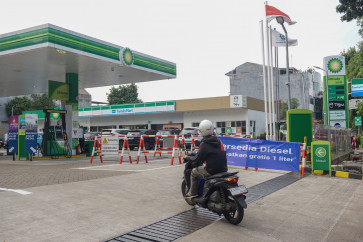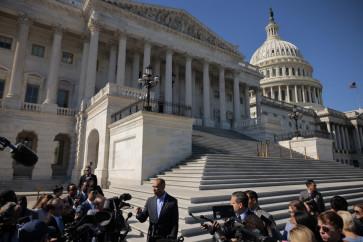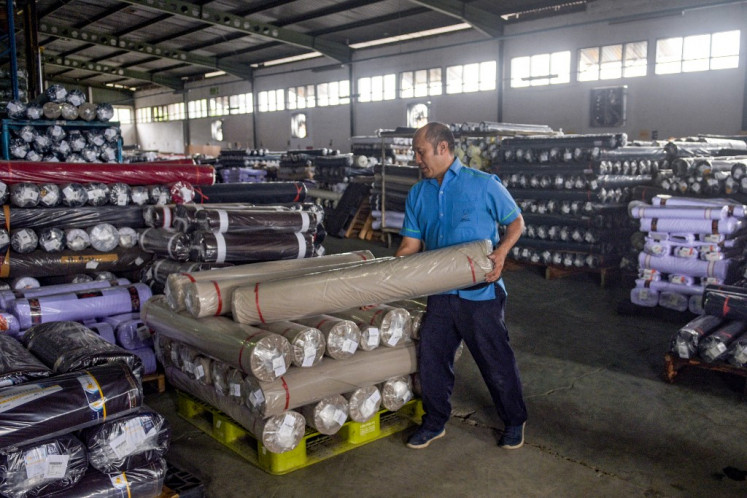Popular Reads
Top Results
Can't find what you're looking for?
View all search resultsPopular Reads
Top Results
Can't find what you're looking for?
View all search resultsBallooning energy subsidy to keep people happy
The proposed 2018 state budget offers some populist measures by allocating more subsidies for energy aimed at keeping the prices of fuel, electricity and gas lower than market prices
Change text size
Gift Premium Articles
to Anyone
The proposed 2018 state budget offers some populist measures by allocating more subsidies for energy aimed at keeping the prices of fuel, electricity and gas lower than market prices.
Subsidies for energy will soar by 15 percent to Rp 103.4 trillion (US$7.7 billion) compared to this year’s allocation.
Of that number, Rp 51.1 trillion will be allocated for fuel and liquid petroleum gas (LPG) and Rp 52.2 trillion for electricity. The allocation for electricity will jump by 15 percent while the allocation for fuel and LPG will rise by 14.8 percent.
Energy subsidies account for 60 percent of the total subsidy worth Rp 172.4 trillion, higher by around 2 percent compared to this year’s revised state budget.
The higher energy subsidies come at a time when the government’s assumption about the Indonesian Crude Price (ICP) remains unchanged at $48 per barrel next year. However, it expects the rupiah will hit Rp 13,500 against the dollar from Rp 13,400 this year.
“This is a very explicit assumption that there will be no increases in fuel, LPG and electricity [prices next year],” Finance Minister Sri Mulyani Indrawati said on Monday.
“The 2018 proposed state budget is designed to maintain our economic momentum so that we can continuously ignite optimism in terms of job creation, maintaining people’s purchasing power and improving the quality of the growth itself.”
The measures, she went on to say, are expected to maintain administered prices. The government targets an inflation rate of 3.5 percent next year.
The proposed energy subsidies ballooned significantly despite massive government cuts to the number of subsidized 900 volt-ampere (VA) electricity recipients to a mere 4.1 million subscribers at the beginning of the year from an initial 22.8 million previously. By the middle of the year, an additional 2 million were added on to the number of subscribers.
Since early this year, the government has drawn criticism from consumers of the 900 VA category, mostly middle class consumers, as most of them no longer pay a subsidized rate. This has led to a double-fold spike in their electricity bills, contributing to inflation.
Despite the government’s assertions that the large sum of subsidies for energy is justified, experts remain baffled by the number.
University of Indonesia (UI) electricity expert Iwa Garniwa questioned the government and PLN’s transparency in calculating the electricity subsidy budget as the massive increase in the electricity rate did not make sense if compared with the equally massive subsidy for consumers.
Energy and Mineral Resources Minister Ignasius Jonan said the ministry had set up a budget range it hoped would be approved by the House of Representatives.
During the early term of his presidency, Jokowi was praised by many for his administration’s decision to scrap the fuel subsidy and shift it to more productive causes such as targeted social aid and infrastructure development.
Next year, however, the government’s proposed budget has sent a mixed signal despite Jokowi and his ministers’ emphasis that the budget will be directed at inequality reduction and sustaining economic growth.
Infrastructure development will get Rp 409 trillion from the budget, a 1.9 percent increase from this year. This growth is the slowest during the President’s tenure.
The Public Works and Public Housing Ministry, which spearheads infrastructure development, will see its budget increase by just 3 percent to Rp 107 trillion, or 7 percent of the central government’s total spending.
Leading the implementation of poverty alleviation programs, the Social Affairs Ministry will receive the biggest budget increase. However, it only ranks tenth on the list of biggest budget recipient.
Food subsidies will also be slashed by more than 63 percent to Rp 7.3 trillion next year while the fertilizer subsidy will decline by 9 percent.
The Religious Affairs Ministry ranks fourth on the list after the Public Works and Public Housing Ministry, the Defense Ministry and the National Police.
Such a large amount of money will be allocated by the ministry for teachers’ allowances and educational assistance for students in religious schools, the Finance Ministry’s budget director general Askolani said.
Meanwhile, the allocation for regional transfers in next year’s state budget will be the lowest since 2015 in terms of amount and spending percentage. The village fund will remain the same as this year at Rp 60 trillion.
Regional transfers, which include the village fund, are aimed at redistributing wealth as Indonesia suffers from growing inequality, which poses a risk to social cohesion.
Next year’s budget deficit is projected to hit Rp 325.9 trillion, or 2.19 percent of gross domestic product (GDP), lower than the 2.9 percent stated in this year’s revised budget.
This measure has been taken as the government wants to brush off concerns about high debt risk.
“The deficit reflects [the government’s] wish to create a healthier state budget while ensuring that its stabilization, allocation and distribution functions are fully implemented,” Sri Mulyani said.










